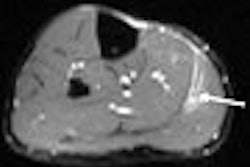NEW YORK CITY - The U.S. Centers for Disease Control and Prevention (CDC) has reported that 68% of women who gave birth in 2002 received an ultrasound exam at some point in their pregnancy. But many women may also not grasp the limitations of second-trimester ultrasound exams, according to research from Stanford University in Stanford, CA, and Northwestern University in Chicago.
"Almost half of patients (in our study) misperceive the diagnostic sensitivity of routine ultrasound in the second trimester," said Dr. Justin Collingham. He presented the research Saturday at the 2007 annual American Institute of Ultrasound in Medicine (AIUM) convention, held last week in New York City.
The researchers sought to determine what factors are associated with misperception regarding routine second-trimester ultrasound, and to discover if there were any demographic predictors or association with information sources. Between October 2004 and April 2006, 150 pregnant women were asked to fill out a questionnaire, which gathered demographic information, answers to questions about the diagnostic sensitivity of ultrasound, and the information sources they used to prepare for their ultrasound exam.
Inclusion criteria for the study included a maternal age less than 35, a gestational age of greater than or equal to 18 weeks and less than 24 weeks, a singleton gestation, and English fluency, as well as no prior second-trimester ultrasound, abnormal serum testing, or diagnostic testing in the present pregnancy.
The patients were asked to identify whether two statements were true or false:
- "Today's ultrasound, if normal, will guarantee that the baby will be born without birth defects."
- "Today's ultrasound, if normal, will guarantee that the baby will be born without chromosomal abnormalities such as Down's syndrome."
Misperception of the diagnostic sensitivity of ultrasound was judged by the incorrect response to either question. Using a Likert scale, the respondents were also asked to rate the importance of information sources, including significant other, friends and family, healthcare provider, prenatal class, TV/books/magazines, and the Internet.
Of the 150 women approached for the study, 145 (96%) enrolled. The women had an average age of 27.4, an estimated gestational age (EGA) of 20 5/7; 52% were primagravid and approximately 50% were Caucasian. The rest of the study group was comprised of African-American, Latina, and Asian ethnicity. Approximately half of the patient population had an annual household income greater than $100,000.
Sixty-two percent of the patients answered the first true/false question correctly, while 56% answered the second correctly. Overall, 68 of the patients (47%) did not recognize the limitations of the ultrasound exam, while 115 (82%) felt confident in their knowledge of ultrasound, Collingham said.
From univariable analysis, the researchers concluded that the factors most frequently associated with misperception included: younger maternal age, greater gestational age at ultrasound, non-Caucasian ethnicity, less education, lower annual income, and the primary use of interpersonal relations (such as a significant other or friends) to gather information about ultrasound.
A gestational age greater than 22 weeks at ultrasound had an odds ratio for misperception of 8.9, while a gestational age of greater than equal to 20 weeks and less than 22 weeks at ultrasound had an odds ratio of 3.3. Gestational age of less than 20 weeks at ultrasound had an odds ratio of 1.0, he said. High school education or less had an odds ratio of 6.0, while ranking interpersonal influences first had an odds ratio of 4.8.
Collingham acknowledged limitations of the study, including the sample size and possible lack of external validity to all ultrasound suites.
In conclusion, almost half of the patients in the study misperceived the diagnostic sensitivity of routine second-trimester ultrasound, Collingham said.
"Lower education and higher gestational age predict patient misperception," he said. "Patients who place primary importance on interpersonal influences are more likely to misperceive these limitations of ultrasound. These findings speak to the need for patient education regarding the limits of ultrasound, preferably before the patient arrives for ultrasound."
By Erik L. Ridley
AuntMinnie.com staff writer
March 19, 2007
Related Reading
Short fetal nasal bone predicts increased likelihood of Down syndrome, February 12, 2007
First-trimester Down's syndrome screening advised for all, January 3, 2007
Nasal bone assessment improves trisomy 21 screening accuracy, August 2, 2006
Ultrasound image size affects sensitivity of Down syndrome screening test, April 24, 2006
Ob/gyn ultrasound yields thorny legal issues, July 13, 2006
Copyright © 2007 AuntMinnie.com




















